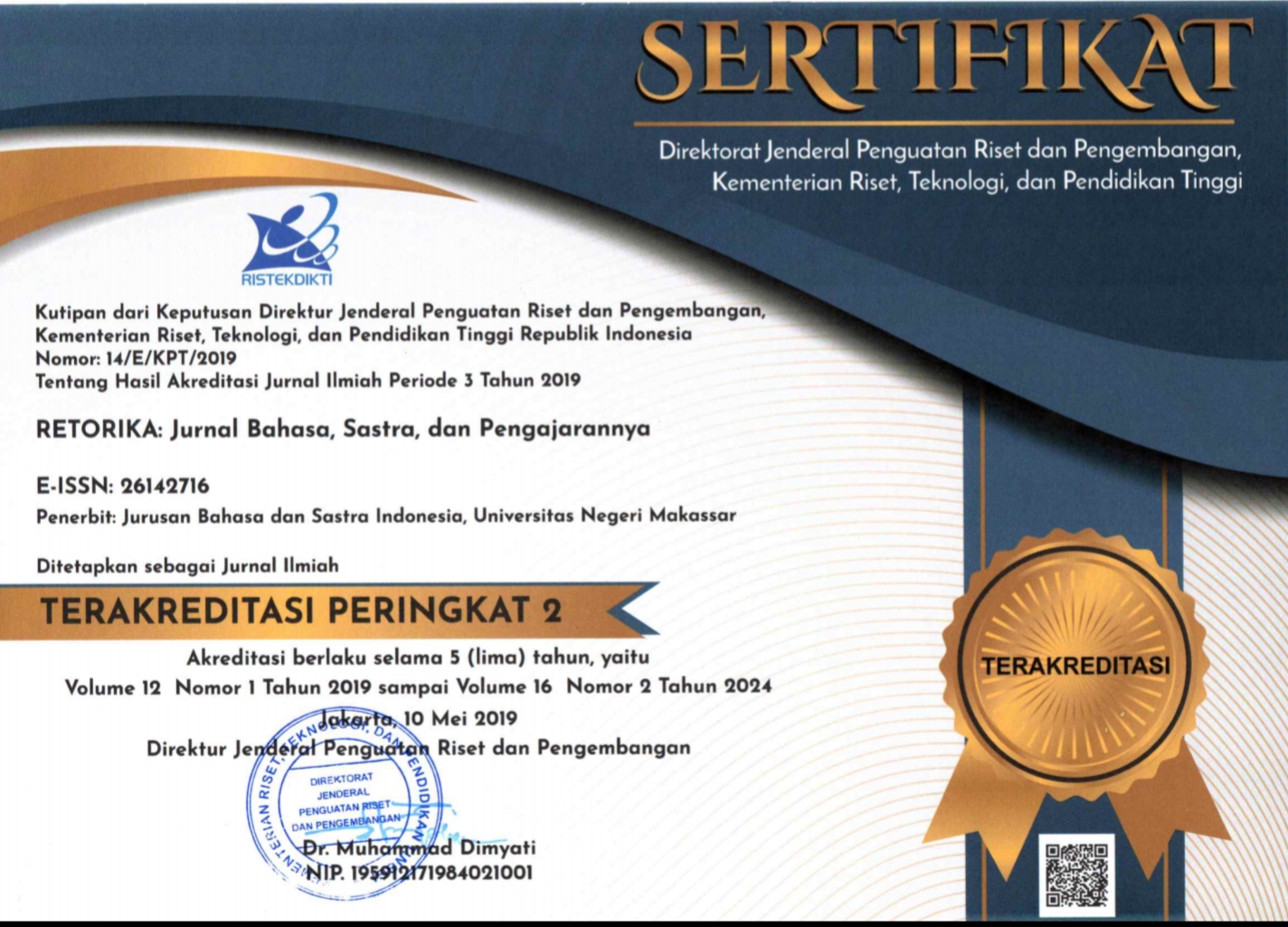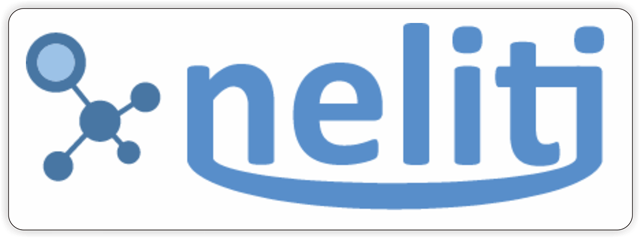HOTS EVALUATION INSTRUMENTS IN INDONESIAN LANGUAGE TEXTBOOKS
(1) Universitas Muhammadiyah Prof. DR. HAMKA Jakarta
(2) Universitas Muhammadiyah Prof. DR. HAMKA Jakarta
(3) Universitas Muhammadiyah Prof. DR. HAMKA Jakarta
(4) Universitas Muhammadiyah Prof. DR. HAMKA Jakarta
(*) Corresponding Author
DOI: https://doi.org/10.26858/retorika.v13i2.13694
Abstract
This article reports on the results of a R &D study on standard evaluation instruments used to measure students’ higher-order thinking skills (HOTS) in Indonesian Language textbooks for the tenth-grade students registered in the academic year of 2019/2020. A qualitative approach to data collection and data analysis was employed. The identification of the research object was carried out by coding various data about the diversity of standard evaluation instruments of HOTS by examining the operational words used and the form of competency measured. The data were analyzed with regard to the level of tendency towards the measurement of certain aspects of thinking. Based on the findings of the research, it can be seen that HOTS contained in Indonesian textbooks class X are already diverse; however, the percentage of diversity is not yet proportional. The aspects include creative thinking (28.3%), critical thinking (37.2%), problem solving (18.6%), and decision making (15.9%) of all evaluation instruments analyzed. A less proportional percentage of each of these aspects shows that the utilization of HOTS standard evaluation instrument development criteria has not been maximally pursued.
Full Text:
PDFReferences
Creswell, J. W. (2014). Rersearch Design Quantitative, Qualitative, and Mixed Methods Approaches (Fourth Edi). United Kingdom: SAGE.
Fatmaira, Z. (2018). Pengembangan Instrumen Penilaian Berbasis Kemampuan Berpikir Tingkat Tinggi (Hots) Untuk Pembelajaran Teks Resensi Pada Siswa Kelas XI SMA Negeri 5 Binjai (Doctoral dissertation). UNIMED.
Gube, M., & Lajoie, S. (2020). Adaptive expertise and creative thinking : A synthetic review and implications for practice. Thinking Skills and Creativity, 35(August 2019), 100630. https://doi.org/10.1016/j.tsc.2020.100630
Hadar, L. L. (2017). Studies in Educational Evaluation Opportunities to learn : Mathematics textbooks and students ’ achievements ☆. Studies in Educational Evaluation, 55(October), 153–166. https://doi.org/10.1016/j.stueduc.2017.10.002
Huang, P. (2019). Learning , Culture and Social Interaction Textbook interaction : A study of the language and cultural contextualisation of English learning textbooks. Learning, Culture and Social Interaction, 21(December 2018), 87–99. https://doi.org/10.1016/j.lcsi.2019.02.006
Kim, K. H. (2011). The creativity crisis: The decrease in creative thinking scores on the Torrance Tests of Creative Thinking. Creativity research journal, 23(4), 285-295.
Korkmaz, M. O. K. & S. K. (2014). Relationship between the high school students perspectives on study skills and the types of state high school in terms of some variables, 152, 1029–1033. https://doi.org/10.1016/j.sbspro.2014.09.268
Krulik, S., & Rudnick, J. A. (1993). Reasoning and problem solving: A handbook for elementary school teachers. Allyn and Bacon.
Lau, K. H., Lam, T., Kam, B. H., Nkhoma, M., Richardson, J., Richardson, J., & Richardson, J. (2017). SC. Computers & Education. https://doi.org/10.1016/j.compedu.2017.11.005
Matondang, C. E. H. (2019). Pengembangan Instrumen Pengetahuan (Kognitif) Berbasis Hots pada Materi Teks Anekdot Kelas X SMA Negeri 1 Tanjungtiram, (Doctoral dissertation). UNIMED.
McCammon, I. 2001. Decision Making for Wilderness Leaders: Strategies, Traps and Teaching Methods. Proc. Wilderness Risk Manager’s Conf. Oct, 26-28, 2001, Lake Geneva, WI, hal. 16-29
Mei, Y., Yunos, J., Othman, W., Hassan, R., & Tze, T. (2012). The needs analysis of learning higher order thinking skills for generating ideas, 59, 197–203. https://doi.org/10.1016/j.sbspro.2012.09.265
Murphy, C., Bianchi, L., Mccullagh, J., & Kerr, K. (2013). Scaling up higher order thinking skills and personal capabilities in primary science : Thinking Skills and Creativity, 10, 173–188. https://doi.org/10.1016/j.tsc.2013.06.005
Rudnick, S. K. J. A. (1996). The new sourcebook for teaching reasoning and problem solving in junior and senior high school.
Runco, M. A., Millar, G., Acar, S., & Cramond, B. (2010). Torrance tests of creative thinking as predictors of personal and public achievement: A fifty-year follow-up. Creativity Research Journal, 22(4), 361-368.
Safi’i, I & Amar, F. (2019). Pelatihan Penyusunan Instrumen Evaluasi Berstandar HOTS bagi Guru-Guru SD di Wilayah Banyudono. Abdimas Dewantara, 2(2), 149–157. https://doi.org/10.30738/ad.v2i2.4176
Safi’i, I & Muljono, H. (2018). Pelatihan Pembelajaran dengan Strategi Critical Thinking Question. Jurnal Abdi Masyarakat, 2(1). https://doi.org/10.30737/jaim.v2i1.237
Sianturi, L. P. (2000). Pengembangan Instrumen Penilaian Teks Deskripsi Berbasis Higher Order Thinking Skills (HOTS) Siswa Kelas VII SMP Swasta Methodist Charles Wesley Medan (Doctoral dissertation. UNIMED.
Stewart, P. J. (2007). No Creative Child Left Behind: Using the Torrance Tests of Creative Thinking to Identify and Encourage Middle School Learners. International Journal of Learning, 14(1).
Thnull, N. (2017). Influence of Explicit Higher-Order Thinking Skills Instruction on S tudents ’ Learning of Linguistics. https://doi.org/10.1016/j.tsc.2017.10.004
Wahyuningtias, H. (2017). Evaluasi Buku Teks Pelajaran Bahasa Jepang Tingkat Dasar “Minna No Nihongo .” Jurnal Penelitian Dan Evaluasi Pendidikan, 21(1), 11–20. Retrieved from http://journal.uny.ac.id/index.php/jpep
Yee, M. H., Yunos, J., Othman, W., Hassan, R., Tee, T. K., & Mohaffyza, M. (2015). Disparity of Learning Styles and Higher Order Thinking Skills among Technical Students. Procedia - Social and Behavioral Sciences, 204(November 2014), 143–152. https://doi.org/10.1016/j.sbspro.2015.08.127
https://beritagar.id/artikel/gaya-hidup/apa-itu-higher-order-thinking-skills-hots
Article Metrics
Abstract view : 717 times | PDF view : 110 timesRefbacks
- There are currently no refbacks.
Copyright (c) 2020 Imam Safi'i, Yeni Witdianti, Wini Tarmini, Prima Gusti Yanti

This work is licensed under a Creative Commons Attribution-NonCommercial 4.0 International License.
Published by:
Department of Indonesian Language, Faculty of Languages and Literature, Universitas Negeri Makassar in cooperate with Asosiasi Dosen Bahasa dan Sastra Indonesia (ADOBSI) and Ikatan Program Studi Pendidikan Bahasa dan Sastra Indonesia (IKAPROBSI).
Address: Department of Indonesian Language Office, DG Building Second Floor, UNM Parangtambung, Daeng Tata Raya Street, Makassar, South Sulawesi, Indonesia
 Email: retorika@unm.ac.id
Email: retorika@unm.ac.id

RETORIKA: Jurnal Bahasa, Sastra,dan Pengajarannya is licensed under a Creative Commons Attribution-NonCommercial 4.0 International License.
















